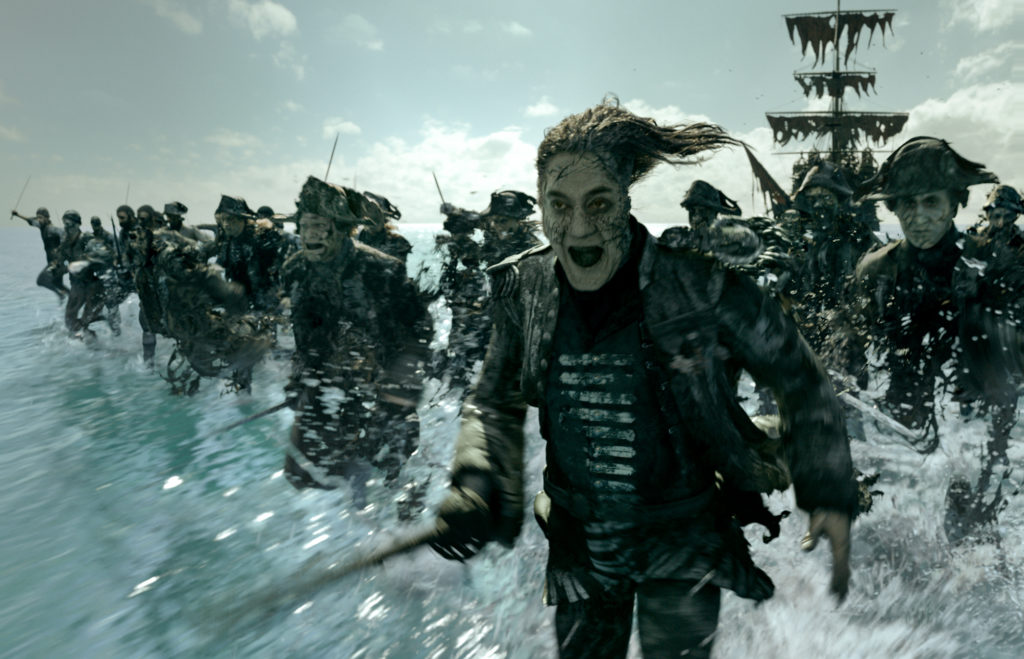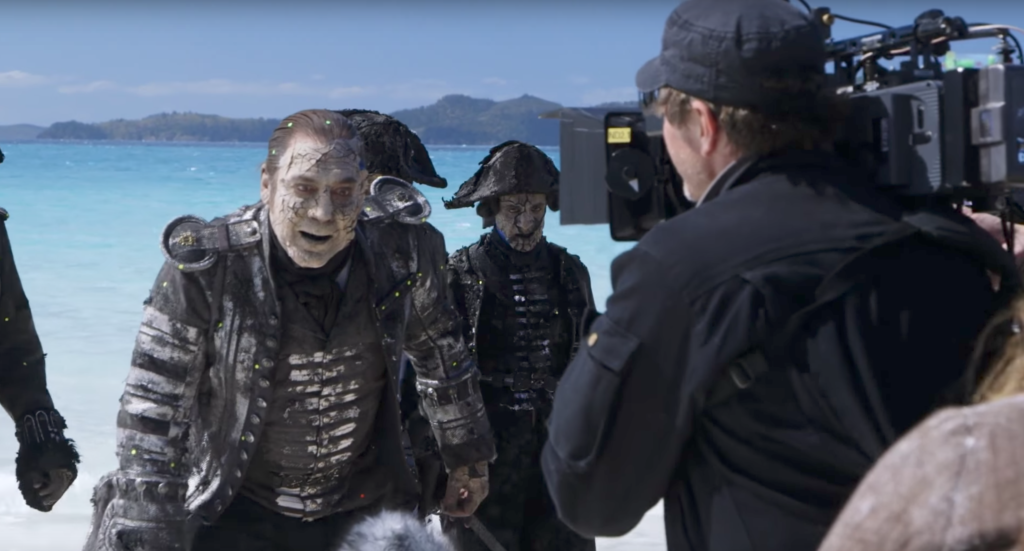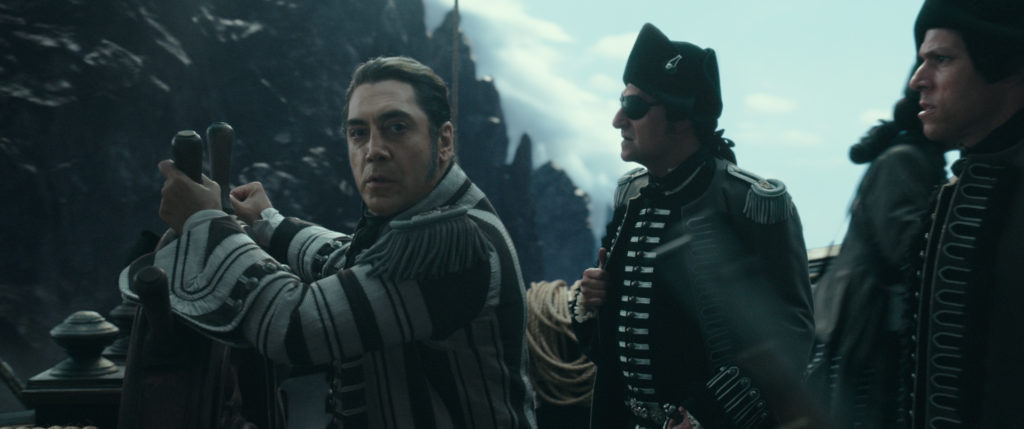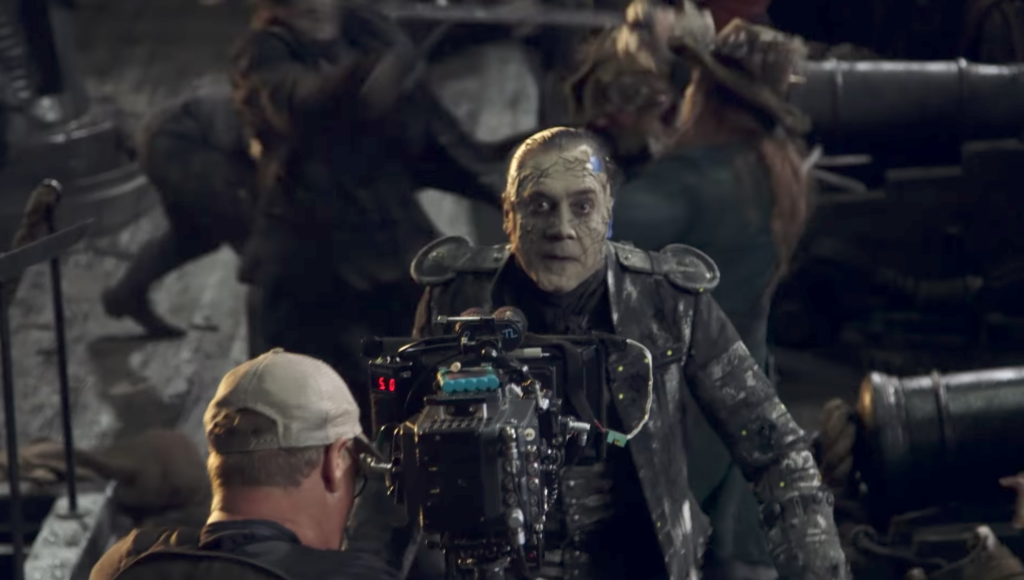
Captain Salazar (Javier Bardem) pursues Captain Jack Sparrow (Johnny Depp) in Pirates of the Caribbean: Dead Men Tell No Tales. (Image: © Disney)
Javier Bardem smiles as he greets a group of journalists at a press event in Beverly Hills, California – and then heads directly toward the spread of coffee and sodas in the back of the small room. “Water.” he announces, like a pirate that’s been deserted on an island. Grabbing a bottle, and quickly twisting it open, he takes a big drink.
The actor is extremely parched.
It’s no wonder that Mr. Bardem needs refreshment, after all, he and the primary cast of Pirates of the Caribbean: Dead Men Tell No Tales have just returned to the U.S. from Paris and China to promote the film. They’re now on the last leg of the press tour. Bardem is the new kid to the franchise, but his reputation as an actor definitely precedes him. He finishes half the bottle in one motion, caps it and smiles again toward the staring journalists.
Thirst quenched, he politely makes his way back to the front of the room and is seated. One of the first questions, ‘How did he prepare for the role as Captain Salazar?’ will consume most of the interview.
The Matador and The Bull
Javier Bardem was born in Spain and started acting very young. He appeared in his first feature film, El picaro (The Scoundrel) when he was six years old. More recently, he was an Academy Award nominated actor and Best Supporting Actor Oscar winner for his terrifying portrayal as Anton in No Country for Old Men (2007). In fact, he is the first Spanish actor to win an Academy Award. Oh, and he’s also fought James Bond (Skyfall).
Now Bardem is playing the ruthless pirate hunter, Captain Armando Salazar, in the fifth installment of the massive POTC movie franchise. While Bardem plays the character briefly as a living person in the movie, it’s Captain Salazar’s ghostly form that Bardem inhabits for the majority of the film.

In Pirates of the Caribbean: Dead Men Tell No Tales the ghostly Captain Salazar is bent on revenge after having been “cursed” to be a ghost through a series of events brought on by none other than Jack Sparrow. (Image: © Disney)
Bardem plays the role darkly, with an evil that hasn’t been seen in other Pirates villains. Bardem lurches across the screen, possessed with vengeance. His Captain Salazar (in what could be Jack Sparrow’s last voyage), is possibly, the scariest villain in the entire Pirates series, and easily one of Disney’s top 10 ghosts.
For the part, Bardem sat in the makeup chair for about three hours a day. But under all that makeup there has to be something driving a performance. “The challenging part,” in playing the character, says Bardem, “Is to have a reason that makes sense to you.”

Captain Salazar (Javier Bardem) pursues Jack Sparrow (Johnny Depp) as he searches for the Trident of Poseidon. (Image: © Disney)
The actor continues, “The idea of somebody being trapped in his own rage and the pain that comes with it, that rage being based on betrayal. For me as an actor, I need to know what I am I doing. And I like the idea of someone being driven by rage and pain.”
He explains how he drew inspiration from his Spanish roots, how when we see Captain Salazar as a living being, “he’s a matador,” and when he’s a ghost, “He’s a wounded animal, a bull. The idea of when he is wounded, the animal is out of breath.”
Bardem also worked closely with the film’s co-directors, Joachim Rønning and Espen Sandberg to help develop Salazar’s mannerisms. Bardem explains, “We worked on the physicality – the voice, the breathing – that’s important.”
Talking about developing the character, Bardem returns to the bullfighting metaphor, “Have you seen a bullfight? The blood that comes out of the animal is so dark – it’s almost black.” So when you see Salazar spewing black liquid in them movie, know that was Bardem’s idea too. He tells us, just before shooting a scene he would down cups of what he calls “monkey poop,” so as he performed the scene, “you see that dark rage pouring out of him.”
Watching Bardem on screen as Salazar is genuinely scary, because the evil comes from a real place, and is not just a special effect.
Visual Effects on the High Seas
Granted, special effects do play a key role in the creation of Captain Salazar. The visual effects for Pirates of the Caribbean: Dead Men Tell No Tales were created by VFX supervisor Gary Brozenich and MPC Montreal (The Jungle Book, Ghost in the Shell, Alien: Covenant, Blade Runner 2049). In addition to the scenes and backdrops, they also created the ghostly effect applied to Salazar and his crew.

Javier Bardem on set as Captain Armando Salazar. Notice the dots on his wardrobe, they’ll be used to match CGI to his live performance. (Image: © Disney)
“It was very important for me to sell the idea of the ghosts coming from the depths of the sea, so I came up with the idea of the floating hair and uniforms,” explains co-director Joachim Rønning.
Filmmakers used standard motion capture on set and added the visual effects in post, after the live action scenes were shot. For the look of Salazar and his crew of spectral sailors, effects wizards created a “shattered” effect, showing parts of the characters blown away. It was important to production that Salazar’s crew looked like broken ghosts, so prosthetics applied to the actor’s face had actual cracks in them.
Bardem’s prosthetic was handmade by Odd Studio, the same special effects group that won for Mad Max: Fury Road. The end result, when combined with the visual effects, is creepily beautiful and – the way his hair floats, almost supernaturally, through the scene and how and Salazar’s crew decay – are genuinely mesmerizing.

Javier Bardem mugs with Johnny Depp on set for Pirates of the Caribbean: Dead Men Tell No Tales. (Image: © Disney)
In fact, Bardem points out the only time he was ever “on the sea” is when he is standing in the tide confronting Jack Sparrow on the beach. All of Bardem’s ship sequences were shot in a studio. Truly, movie magic.
Like Salazar, Javier Bardem is a powerful presence. He’s held the attention of the journalists for almost a half hour, but it only feels like a few minutes.
The session ends, Bardem stands, thanks the group of journalist and starts off for his next appointment. As he makes his way out of the room, a group of people in the hallway part like the ocean does in the movie and one guy jokingly shouts, “Captain Salazar, coming through.”
Yes, definitely, get out of the way of the bull.
